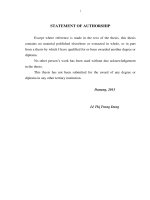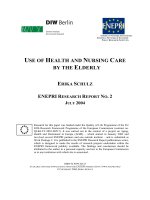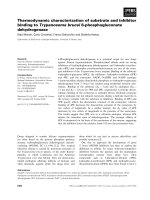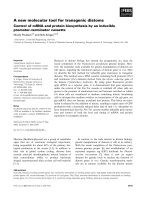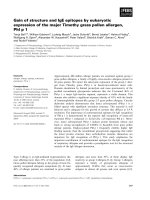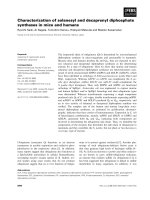Characterization of electromagnetic and light scattering by nano scaled objects
Bạn đang xem bản rút gọn của tài liệu. Xem và tải ngay bản đầy đủ của tài liệu tại đây (12.94 MB, 164 trang )
CHARACTERIZATION OF ELECTROMAGNETIC AND LIGHT
SCATTERING BY NANO-SCALED OBJECTS
SHE HAOYUAN
B. Eng, Harbin Institute of Technology, 2005
Submitted for the degree of PhD of Engineering in joint program by Nanoscience
and Nanotechnology Initiative & Department of Electrical and Computer
Engineering
National University of Singapore
2009
Acknowledgement
Firstly, I would like to take this opportunity express my most sincere gratitude to
my supervisor Professor Le-Wei Li, for his guidance, strong supports, and under-
standings throughout my postgraduate program. Also I want to thank Professor
Chua Soo Jin for his guidance and invaluable discussions.
The author also wants to thank Dr. Wei Bin Ewe, Dr. Cheng-Wei Qiu and
Dr. Hai-Ying Yao for their helpful discussions on code development. The author’s
appreciation also goes to the other Radar and Signal Processing Lab and Microwave
Lab members: Dr. Kai Kang, Mr. Tan Hwee Siang, Mr. Tao Yuan, Mr. Li Hu, Miss
Ya-Nan Li, Miss Yu-Ming Wu and the senior lab officers Mr. Ng and Mr. Sing.
Most importantly, the author is also grateful to his parents for their always
understandings, supports and love. Without you, I could never finish this tough job
successfully. Thank you so much!
i
Publication List
1. L W. Li, H Y. She, W B. Ewe, S. J. Chua, Olivier J. F. Martin, and Juan R.
Mosig, ”Optical Shielding Nano-Systems Achieved by Multiple Metallic Nano-
Cylinders under Plasmon Resonances”, to be submitted to Journal of Applied
Physics, 2009
2. H Y. She, L W. Li, W B. Ewe, S. J. Chua, Olivier J. F. Martin, and Juan R.
Mosig, ”Resonance of Cylindrical Structures with High Relative Permittivities–
Enhancement of the Field and Applications in Optical Waveguide”, to be sub-
mitted to Physical Review B, 2009
3. H Y. She, L W. Li, S. J. Chua, W B. Ewe, Olivier J.F. Martin, and Juan
R. Mosig, ”Enhanced Backscattering by Multiple NanoCylinders Illuminated
by TE Plane Wave”, Journal of Applied Physics, vol. 104, no. 1, pp. 064310,
September 2008
4. L W. Li, Z C. Li, H Y. She, S. Zouhdi, Juan R. Mosig, and Olivier J.F. Mar-
tin, ”A New Closed Form Solution to Light Scattering by Spherical Nanoshells”,
Accepted by IEEE Transactions on Nanotechnology, vol. 7, 2008
ii
Publication List iii
5. L W. Li and H Y. She, ”High Energy Scattered by Silver Coated Nano Struc-
tures”, International Journal of Microwave and Optical Technology, pp. 150-
156, 2008-5-38
6. H Y. She, L W. Li, Olivier J.F. Martin, and Juan R. Mosig, ”Surface Polari-
tons of Coated Cylinders Illuminated by Normal-Incident TM and TE Plane
Waves ”, Optics Express, vol. 16, no. 2, pp. 1007-1019, January 2008
Summary
In nano-scale, the conducting materials are found to behave the dielectric properties
with negative real part of the relative permittivities (known as plasmonic materials
with the effective dimensions ranging from 20 nm to 200 nm) and the dielectric ma-
terials are found to have different optical properties compared to the bulk properties
(such as Si and Ge). Due to their peculiar optical properties, nanoscaled materi-
als can be applied in optical coating, optical communications (optical waveguides),
surface cleaning, etching, scattering enhancement equipment, and data storage. In
this thesis, I have studied the optical properties including the enhancement of the
scattering, the transmission properties of silicon nanorods, the control of shifting the
frequencies of the plasmon resonances by coated nanostructures, and the potential
applications of plasmonic materials, from simple to complex structures (for both
single and multiple scatterers). Further more, various numerical and theoretical in-
vestigation methods are used for analyzing the electromagnetic and light scattering
problems.
Before studying the physical properties of the nano-objects, the basic studies of
the electromagnetic wave propagation, scattering and resonances of cylinders and
iv
SUMMARY v
spheres are conducted. These studies help to understand the physical characteristics
of the nano-objects better. For example, light scattering by a single sphere and
a single cylinder is studied using the exact scattering theory–Mie theory and the
resonance properties for electrically small structures are presented. The scattered
near-field energy intensity is found to be significantly enhanced. Next, the coated
nanostructures are studied and their effects on resonance shifts according to different
frequencies are shown. The results are helpful in enhancing the scattered fields of
coated nanostructures. The surface plasmon resonances of the coated structures
are also shown, while the closed form solutions are given and compared with the
exact solutions, which are found to be very effective over a wide range of electrical
dimension. The range with a strong scattered energy is given and the formulas
for the scattered energy are derived for both plasmonic coated nanospheres and
nanocylinders. The results are applicable over a wide range of electrical dimensions
and relative permittivities, and they are more accurate than the previous works.
Subsequently, the multiple scattering by the plasmonic nanocylinders is dis-
cussed. The great backscattering enhancement effect is studied and compared with
that of a single plasmonic nanocylinder. The incident wave is assumed to be TE
(transverse electric) plane wave which is capable of exciting the plasmon resonance
of cylindrical structures. The results can be applied in nanopatterning, surface
cleaning and data storage.
Finally, with multiple nanocylinders, we can also achieve a shielding nanosystem
composed of metallic nanocylinders near plasmon resonances. The shielding effects
SUMMARY vi
are found to be very good and shielding systems are very flexible and small in size.
We have also proposed an optical waveguide composed of silicon nanowires. The
transmission is based on the great coupling effects produced by silicon nanowires
with high relative permittivities. Enhanced scattering property of multiple silicon
nanocylinders has also been discussed for different pattern arrangements. And we
have provided some new closed form solutions of the scattering by electrically small
cylinders and the results are more accurate than the commonly used one for cylinders
with high relative permittivities.
Contents
Acknowledgement i
Publication List ii
Summary iv
Contents vii
List of Figures xi
1 Introduction 1
1.1 Optical Properties of Nanoscaled Objects . . . . . . . . . . . . . . . . 3
1.1.1 Optical Constants of Noble Metals . . . . . . . . . . . . . . . 3
1.1.2 Surface Plasmon Resonances of Metallic Nano-Objects . . . . 4
vii
CONTENTS viii
1.2 Optical Constants of Other Dielectric Materials . . . . . . . . . . . . 20
1.3 Thesis Work . . . . . . . . . . . . . . . . . . . . . . . . . . . . . . . . 21
2 Optical Properties of Coated Nano-Cylinders 24
2.1 Introduction . . . . . . . . . . . . . . . . . . . . . . . . . . . . . . . . 24
2.2 Surface Modes of Plamonic Coated Cylinders . . . . . . . . . . . . . . 26
2.2.1 Theoretical Foundation . . . . . . . . . . . . . . . . . . . . . . 26
2.2.2 Coated Cylinders Scattered by TM Plane Wave . . . . . . . . 32
2.2.3 Coated Cylinders Scattered by TE Plane Wave . . . . . . . . 40
2.2.4 Peak Values of the Near-Field Energy Intensity . . . . . . . . 42
2.3 Energy Intensity Enhancement of Plamonic Coated Cylinders . . . . 43
3 Optical Properties of Coated Nano-Spheres 47
3.1 Introduction . . . . . . . . . . . . . . . . . . . . . . . . . . . . . . . . 47
3.2 Closed Form Solutions to Light Scattering by Coated Spheres . . . . 50
3.2.1 Basic Formulas . . . . . . . . . . . . . . . . . . . . . . . . . . 50
3.2.2 New Closed Form Solution to Intermediate Coefficients A
n
and B
n
. . . . . . . . . . . . . . . . . . . . . . . . . . . . . . . 55
CONTENTS ix
3.2.3 New Closed Form Solutions to Scattering Coefficients a
n
and b
n
62
3.3 Energy Intensity Enhancement of Plamonic Coated Nanospheres . . . 72
3.3.1 Parameter Derivation of High Scattered Energy Region for
Plasmonic Coated Spheres . . . . . . . . . . . . . . . . . . . . 72
3.3.2 Energy Distribution of a Plasmonic Coated Nanosphere . . . . 77
4 Multiple Scattering by NanoCylinders 79
4.1 Introduction . . . . . . . . . . . . . . . . . . . . . . . . . . . . . . . . 79
4.2 Enhanced Backscattering by Multiple NanoCylinders Illuminated by
TE Plane Wave . . . . . . . . . . . . . . . . . . . . . . . . . . . . . . 82
4.2.1 Theoretical Foundation . . . . . . . . . . . . . . . . . . . . . . 82
4.2.2 Scattering Properties of a Single Plasmonic Cylinder . . . . . 84
4.2.3 Scattering by Multiple Plasmonic Cylinders in Arrays . . . . . 87
4.2.4 Scattering by Multiple Plasmonic Cylinders with Different
Distributions . . . . . . . . . . . . . . . . . . . . . . . . . . . 91
4.3 Optical Shielding Nano-systems Achieved by Multiple Metallic Nano-
cylinders under Plasmon Resonances . . . . . . . . . . . . . . . . . . 93
4.3.1 Shielding Properties of Multiple Plasmonic Cylinders . . . . . 95
CONTENTS x
4.3.2 Shielding System Test Using a Single Cylinder as the Core
Object . . . . . . . . . . . . . . . . . . . . . . . . . . . . . . . 100
4.3.3 Dissipation Effect on the Shielding System . . . . . . . . . . . 103
5 Resonance of Cylindrical Structures 106
5.1 Introduction . . . . . . . . . . . . . . . . . . . . . . . . . . . . . . . . 106
5.2 Theoretical Foundations and Discussions . . . . . . . . . . . . . . . . 108
5.3 Field Enhancement by Multiple Si NanoCylinders . . . . . . . . . . . 112
5.4 Optical Waveguide Composed of Si NanoCylinders . . . . . . . . . . . 115
6 Conclusions 119
A Field Intensity Distribution of NanoCylinders 122
List of Figures
1.1 e(a
1
) for different relative permeabilities versus the relative permit-
tivity. . . . . . . . . . . . . . . . . . . . . . . . . . . . . . . . . . . . 8
1.2 e(a
1
) for different relative permeabilities versus q. . . . . . . . . . . 9
1.3 e(a
1
) at resonances versus
r
and µ
r
for different q. . . . . . . . . . . 9
1.4 e(b
1
) for different relative permittivities versus the relative perme-
ability. . . . . . . . . . . . . . . . . . . . . . . . . . . . . . . . . . . . 10
1.5 e(b
1
) for different relative permittivities versus q. . . . . . . . . . . . 10
1.6 e(b
1
) at resonances versus
r
and µ
r
for different q values. . . . . . . 11
1.7 Energy intensity distribution of scattering by a single sphere for q =
0.1 with different relative permittivities and permeabilities. The
sphere is resonant by the first order mode. . . . . . . . . . . . . . . . 12
1.8 Energy intensity distribution of scattering by a single sphere for q =
0.1 with different relative permittivities and permeabilities. The
sphere is resonant by the second order mode. . . . . . . . . . . . . . . 13
xi
LIST OF FIGURES xii
1.9 Geometry for scattering of a plane wave by a cylinder. . . . . . . . . 13
1.10 Properties of different orders of the scattering coefficient. In the case
of a lossless cylinder, scattering coefficients of all orders can reach
1 at their maximum. As q increases or with smaller order n, the
bandwidth gets bigger. . . . . . . . . . . . . . . . . . . . . . . . . . . 15
1.11 Properties of different orders of the scattering coefficient. In the case
of a lossless cylinder, scattering coefficients of all orders can reach
1 at their maximum. As q increases or with smaller order n, the
bandwidth gets bigger. . . . . . . . . . . . . . . . . . . . . . . . . . . 15
1.12 For
= 0, −(a
2
) can also reach 1. But the coefficients of high
orders can be influenced greatly by even a very small
. . . . . . . . 16
1.13 Energy intensity distribution of light scattering by a single plasmonic
cylinder with
r
= −1. The incident wave has an amplitude of H
0
= 1.
It is apparent that the near-field scattered energy is enhanced. . . . . 17
1.14 The energy distribution for a single cylinder when
r
= −1.004. . . . 17
1.15 The energy distribution for a single cylinder when
r
= −1.00337. . . 18
1.16 The energy distribution for a single cylinder when
r
= −1.00125 ···. 18
2.1 Geometry for scattering of a plane wave by a coated cylinder. . . . . 26
2.2 Variation of the scattering coefficient A
n
with various parameters. . . 33
LIST OF FIGURES xiii
2.3 The density plot of −e(A
1
) versus µ
2
and µ
3
. . . . . . . . . . . . . . 34
2.4 The energy distributions of the coated cylinder near resonances. . . . 35
2.5 −e(A
1
) versus µ
2
for different parameters. . . . . . . . . . . . . . . 37
2.6 The density plot of −e(A
1
) versus µ
2
and µ
3
for the first resonance
at q = 0.1 and p = 0.05. . . . . . . . . . . . . . . . . . . . . . . . . . 38
2.7 The density plot of −e(A
1
) versus µ
2
and µ
3
for the first resonance
at q = 0.2 and p = 0.05. . . . . . . . . . . . . . . . . . . . . . . . . . 38
2.8 The energy distributions of the coated cylinder near the first resonance. 39
2.9 The energy distributions of the coated cylinder near the second reso-
nance. . . . . . . . . . . . . . . . . . . . . . . . . . . . . . . . . . . . 39
2.10 The energy intensity I
distributions of a coated cylinder near reso-
nance illuminated by a TE plane wave. . . . . . . . . . . . . . . . . . 40
2.11 Energy intensity of coated cylinder with or without damping term
illuminated by a TE plane wave. . . . . . . . . . . . . . . . . . . . . . 40
2.12 Energy intensity of a silver coated nanocylinder. . . . . . . . . . . . . 41
2.13 Ranges of the relative permittivities in which low dissipations for
nano-cylinders with silver coating can be found. The points between
the two curves should be selected. . . . . . . . . . . . . . . . . . . . . 43
LIST OF FIGURES xiv
2.14 Ranges of the relative permittivities within which low dissipations for
nano-cylinders with silver core can b e found. Herein we cho ose the
resonance with bigger relative permittivities. . . . . . . . . . . . . . . 43
2.15 The near field energy intensity distribution of a nano-cylinder with
silver core for the imaginary part of different relative permittivities. . 45
3.1 Geometry of light scattering by a spherical nanoshell in hosting medium. 50
3.2 The relative errors of coefficients A
1
, A
2
, and B
1
obtained in this the-
sis and also in Ref. 73, all compared with the exact solution obtained
using the Mie scattering theory. The bullet-dotted curve “−−•−−”
denotes the results in [73] while the solid curve “——–” stands for
the result in this thesis. . . . . . . . . . . . . . . . . . . . . . . . . . . 61
3.3 The exact co efficient a
1
versus the spherical core radius x ∈ (0.01, 1.0)
and the spherical nanoshell thickness t ∈ (0.01, 0.4). The other elec-
trical parameters are
1
= (5.44/1.78)
0
,
3
=
0
, and
2
= (
1
+
3
)/2
while µ
1
= µ
2
= µ
3
= µ
0
. . . . . . . . . . . . . . . . . . . . . . . . . . 65
3.4 The relative errors (with respect to the exact solution) of approximate
coefficient a
1
formulas derived here in this thesis versus the spherical
core radius x ∈ (0.01, 1.0) and the spherical nanoshell thickness t ∈
(0.01, 0.4). The other electrical parameters used here are the same as
those in Fig. 3.2 and Fig. 3.3, and they will be used for the future
numerical results and thus omitted later. . . . . . . . . . . . . . . . . 68
LIST OF FIGURES xv
3.5 The variation of |a
2
| and the relative error (with respect to the exact
solution) of the formulas derived in this thesis versus the spherical
core radius x ∈ (0.01, 1.0) and the spherical nanoshell thickness t ∈
(0.01, 0.4). . . . . . . . . . . . . . . . . . . . . . . . . . . . . . . . . . 70
3.6 The relative error (with respect to the exact solution) of the formu-
las |b
1
| derived in this thesis versus the spherical core radius x ∈
(0.01, 1.0) and the spherical nanoshell thickness t ∈ (0.01, 0.4). . . . . 72
3.7 Ranges of the relative permittivities in which low dissipations for
nanoparticles with silver core can be found. The points between the
two curves should be selected. . . . . . . . . . . . . . . . . . . . . . . 74
3.8 Ranges of the relative permittivities within which low dissipations for
nanoparticles with silver coating can be found. Herein we choose the
resonance due to bigger relative permittivities. . . . . . . . . . . . . . 74
3.9 The near field energy intensity distribution of the nanoparticle with
a silver core with the instrumental error. The peak value of the
scattered energy intensity may vary from (a) to (c). . . . . . . . . . . 76
3.10 Total near field energy intensity distribution of a nanoparticle with
silver coating. . . . . . . . . . . . . . . . . . . . . . . . . . . . . . . . 77
4.1 Geometry for the scattering of a plane wave by multiple cylinders in
free space. . . . . . . . . . . . . . . . . . . . . . . . . . . . . . . . . . 82
LIST OF FIGURES xvi
4.2 e(A
1
) versus e(
r
) for different electrical dimensions q and damping
terms m(
r
). . . . . . . . . . . . . . . . . . . . . . . . . . . . . . . . 84
4.3 e(A
2
) versus e(
r
) for different electrical dimensions q and damping
terms m(
r
). . . . . . . . . . . . . . . . . . . . . . . . . . . . . . . . 84
4.4 e(A
1
) versus e(
r
) for damping term m(
r
) and different electrical
dimensions q. . . . . . . . . . . . . . . . . . . . . . . . . . . . . . . . 85
4.5 Scattering by a single plasmonic cylinder with different relative per-
mittivities. The wavelength is 366 nm and radius of the cylinder is
17.5 nm. In Fig. 4.5(a), we present the lossless case and in Fig. 4.5(b),
the damping term is considered. . . . . . . . . . . . . . . . . . . . . . 86
4.6 Scattering by a single array with different numb ers of identical plas-
monic resonant cylinders. The spacing between two adjacent cylin-
ders is 60 nm and radii of the cylinders are both 17.5 nm. . . . . . . . 87
4.7 Scattering by a double array with different numbers of identical res-
onant plasmonic cylinders. The spacing between two adjacent cylin-
ders and the distance between two single arrays are both 60 nm. . . . 88
4.8 Scattering by two arrays of identical plasmonic resonant cylinders.
The spacing between two adjacent cylinders is 60 nm, but the distance
between two single arrays varies from (a) 140 nm, via (b) 200 nm, to
(c) 300 nm. . . . . . . . . . . . . . . . . . . . . . . . . . . . . . . . . 90
LIST OF FIGURES xvii
4.9 Scattering by multiple plasmonic nanocylinders. The near-field mag-
netic intensity distribution is shown. Significant enhancement of
backscattering can be observed. . . . . . . . . . . . . . . . . . . . . . 92
4.10 Magnetic field distribution of a nano shielding system consisting of
12 identical nanocylinders with various incident wavelength λ
0
(one
circular layer). . . . . . . . . . . . . . . . . . . . . . . . . . . . . . . . 95
4.11 Magnetic field distribution of a nano shielding system consisting of
28 identical nanocylinders with various incident wavelengths λ
0
(two
circular layers). . . . . . . . . . . . . . . . . . . . . . . . . . . . . . . 96
4.12 Magnetic and electric field distributions of a shielding nano system
consisting of 36 identical nanocylinders (with three circular layers). . 97
4.13 Magnetic and electric field distributions of a nano shielding system
consisting of 42 identical nanocylinders (with three circular layers). . 98
4.14 Total magnetic field intensity distributions at the origin point versus
the incident wavelength. . . . . . . . . . . . . . . . . . . . . . . . . . 99
4.15 Total magnetic field intensity distributions at the origin point when
= 0.01. . . . . . . . . . . . . . . . . . . . . . . . . . . . . . . . . . 100
4.16 Magnetic and electric field distributions of a silicon nanocylinder in
the nano shielding system with a = 35 nm. . . . . . . . . . . . . . . . 101
LIST OF FIGURES xviii
4.17 Magnetic and electric field distributions of a nanocylinder in the nano
shielding system with
r
= 2 and a = 17.5 nm. . . . . . . . . . . . . . 102
4.18 Magnetic and electric field distributions of a nanocylinder in the nano
shielding system with
r
= 2 and a = 35 nm. . . . . . . . . . . . . . . 103
4.19 Magnetic and electric field distributions of a nanocylinder in the
shielding nanosystem with
r
= 2 and a = 35 nm. . . . . . . . . . . . 104
5.1 The real and imaginary parts of A
0
. The three curves stand for the
exact solution (E), the traditional closed form solution (T) and the
new closed form solution we derived (N). One can see that the curve
T is not accurate when q grows bigger. . . . . . . . . . . . . . . . . . 108
5.2 The electric and magnetic field intensity distribution of a Si nanocylin-
der with incident wavelength λ
0
= 388.5 nm. The incident wave has
an amplitude of E
0
= 1. It is apparent that the magnetic near-field
can be enhanced significantly. . . . . . . . . . . . . . . . . . . . . . . 109
5.3 Poynting vector (normalized incident wave) of a Si nanocylinder at
(x, y) = (−a, 0) nm. . . . . . . . . . . . . . . . . . . . . . . . . . . . . 111
5.4 Field distribution of different numbers of Si nanocylinders arranged
in an array. In Fig. 5.4(a), the distance between each two nearby
nanocylinders is 25 nm. In Figs. 5.4(b) and (c), the distance is 30 nm. 113
LIST OF FIGURES xix
5.5 3 Si nanocylinders exhibiting enhanced transmission, enhanced scat-
tering and enhanced backscattering with different distributions. . . . 114
5.6 Proposed optical waveguide composed of 104 Si nanocylinders with
different incident wavelength. It is apparent that at 3.2 eV, the trans-
mission effects are the best. . . . . . . . . . . . . . . . . . . . . . . . 116
5.7 Three different kinds of optical waveguides at 3 .2 eV. One can see
that the guiding effects are not good compared to the one shown in
Fig. 7(b). . . . . . . . . . . . . . . . . . . . . . . . . . . . . . . . . . 117
A.1 Magnetic field intensity distribution when m = 0 with different pa-
rameters. Here we have normalized the amplitude of the incident
wave. . . . . . . . . . . . . . . . . . . . . . . . . . . . . . . . . . . . . 123
Chapter 1
Introduction
With the rapid technological advancements, the size of the objects we can investi-
gate is becoming smaller and smaller, so it becomes p ossible and desirable to study
the properties of the microcosmic world–the nano-objects. As is well-known, one
nanometer is one billionth of a meter and the concept of “nano-technology” was
firstly proposed by a physicist Richard Feynman at the American Physical Society
meeting on December 29, 1959. He described the possibility of developing a process
which can manipulate individual atoms and molecules. Over the past half a century,
scientists have been making continuous contributions to engineering applications and
theoretical research on the objects in nanoscale. Now nanotechnology leads to the
fields of theoretical sciences and applied technologies whose aim is to investigate the
objects with dimensions of 100 nanometers or even smaller. It is considered to be
a multidisciplinary subject containing various fields such as applied and theoreti-
cal physics (for instance, fiber optics, fluid dynamics, laser physics, communication
physics, computational physics, and accelerator physics), materials processing sci-
1
CHAPTER 1. INTRODUCTION 2
ence (for instance, ionic crystals, covalent crystals, metals, semiconductors, poly-
mers, and composite materials), interface and colloid science (for instance, colloids,
and heterogeneous systems), device physics (for instance, semiconductor device,
technology CAD, and transistor), self-replicating machines and rob otics, chemical
engineering (for instance, supramolecular chemistry, quantum chemistry, computa-
tional chemistry, and inorganic chemistry), mechanical engineering (for instance,
statics, dynamics, fluid mechanics, mechanism design, thermo dynamics, heat trans-
fer, and energy conversion), biological engineering (for instance, bio-based materials,
biocatalysis, biocompatible material, bioinformatics, biomechanics , and biosensors),
and electrical engineering (for instance, electronics, microelectronics, and optical
communication). Nanotechnology can also be regarded as an extension of existing
sciences into the nanoscale using a newer, more modern and accurate analyzing
method.
Nano-scaled objects are attracting more attention since they have shown the
interesting properties different from their behaviors in the normal circumstances. In
this thesis, we will discuss the optical properties exhibited of nano-scaled regime.
One of the most attractable phenomena is optical property of the nobel metals.
Noble metals (such as copper, silver, and gold) behave like dielectric materials at
nanoscale and these nobel metals are called plasmonic materials [19]. When excited
by an electromagnetic wave, the surfaces of these metals will have a greater scattered
energy, this phenomenon is named as the surface plasmon resonance. Surface plas-
mon polariton (SPP), the phenomenon of an electromagnetic propagating between a
metal and a dielectric medium (always vacuum or air), has attracted great attention
CHAPTER 1. INTRODUCTION 3
over the last decade. It has a negative real part of the relative permittivity in some
portion of the photonic energy spectrum. The electromagnetic field is confined to
the near surface of the plasmonic structures and has an effect of field enhancement
which can lead to higher energy intensity distribution around the interface. This
property makes the resonances of plasmonic structures possible and practical. Di-
mensions of the nano-objects in which surface plasmon polariton (SPP) happens
are usually considered in the range from 20 to 200 nm. Some photonic applications
such as surface cleaning, etching, imaging, nanopatterning, and bio-sensoring in very
small scale can be achieved.
1.1 Optical Properties of Nanoscaled Objects
1.1.1 Optical Constants of the Noble Metals
It is important and desirable to know the relative permittivities of nanoscaled nano-
objects. So there has been a trend of measuring the optical constants of noble
metals. Optical properties of solid copper were measured in a wavelength range from
0.365 to 2.5 micrometers in [1]. It was observed that the results obtained were very
sensitive to surface conditions of the samples. The normal-incident reflectance of Zn
single crystals is measured from 0.6 to 4.0 eV in [2]. We can see that Drude’s free-
electron theory failed to describe the relative permittivities in the visible and near-
ultraviolet spectrum regions. The experimental accuracy is also increased gradually
by improving the testing methods. Continuous works have made to the accuracy of
CHAPTER 1. INTRODUCTION 4
the optical constants of noble metals [3–14]. In [3], the absorption in the visible and
ultraviolet region was considered to be due to the transitions from the d bands to
the sp bands. The free-electron contributions could be separated in more accurate
measurements and detailed band-structure calculations for Ag and Cu [4,5]. Effects
of the stress on the optical constants are shown in [6] for Cu, [7] for Ag and [7–
9] for Alloys. The optical properties of Au were investigated by means of thin
semitransparent films [10]. Wavelength modulation spectrum of copper was studied
in [11] and the optical properties of gold in [12]. P. B. Johnson and R. W. Christy
measured the optical constants of copper, silver and gold with an oblique-incidence
thin-film technique [14] and measurements of copper and nickel as a function of
temperature were also shown [13]. In this thesis, we will use the results obtained
in [14].
1.1.2 Surface Plasmon Resonances of the Metallic Nano-
Objects
Surface plasmon resonances of metallic nano-objects occur at e(
r
) = −(1 + 1/n),
where n = 1, 2, ···, for spherical structures [28] and e(
r
) = −1 [29] for cylindrical
structures (
r
is the relative permittivity of the nano-objects). It has been found
that the near-field energy can be significantly enhanced as well as the scattering
and total cross sections (far-field characteristics). In this part, we will illustrate the
optical properties of spherical and cylindrical plasmonic structures.
CHAPTER 1. INTRODUCTION 5
Surface Plasmon Resonances of Nanospheres
Scattering of electromagnetic waves by spherical particles has been a subject attract-
ing lots of interests over the past a few decades and was studied thoroughly using
the classical Mie theory by matching the boundary conditions [15]. Bohren plotted
the field lines (Poynting vector) around a sphere and provided the argument that a
particle can absorb more than the light incident on it [16]. Usually, as the electrical
dimension of a scattering object becomes smaller, the Rayleigh scattering (the first
order approximation of Mie scattering) will dominate [17, 18] the field distribution.
With the recent development of nanotechnologies and some progresses of nanoscience,
it becomes desirable and timely demanded to characterize scattering properties of
light waves by nanoscaled objects including the nanoparticles. Nanoparticles have
shown interesting optical properties and are important for modern photonic ap-
plications [19–22]. Plasmon was firstly described as the interactions of collective
and individual particles in metals by Pines and Bohm [23, 24]. As the research
goes deeper, the low frequency plasmons in metallic mesostructures was reported
by Pendry’s group in [25]. Recently, Wang and Luk’yanchuk plotted the energy dis-
tribution and Poynting vector around electrically small objects (plasmonic spheres)
and compared the resluts derived with dipole approximations and the exact Mie
theory [26, 27]. It was shown that the plasmon resonances for electrically small
nanospheres happen when the real part of the relative plasmon permittivity is near
e[
r
(ω
n
)] = −(n + 1)/n, where n = 1, 2, ··· [28]. At this time, the imaginary part
of the denominator of cross-section will vanish and the real part of scattering coef-

